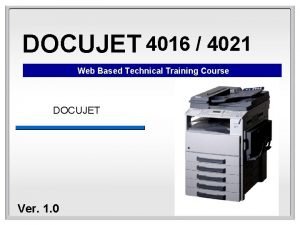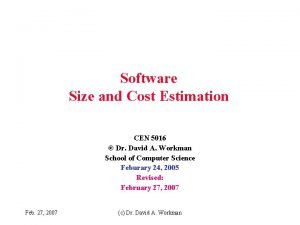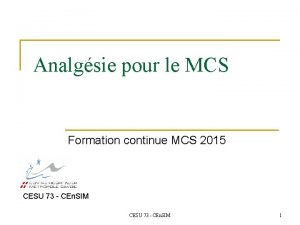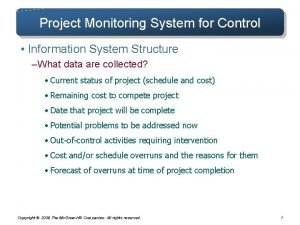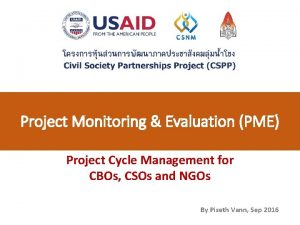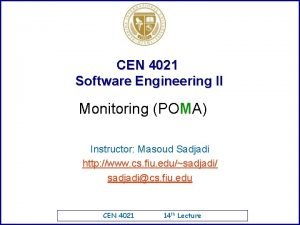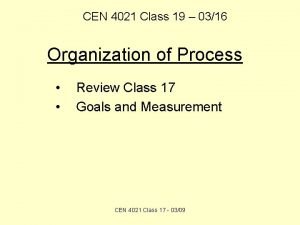CEN 4021 Class 22 0404 Project Monitoring Review























- Slides: 23

CEN 4021 Class 22 – 04/04 Project Monitoring • • • Review Class 19 Overview of Project Monitoring Data gathering and Monitoring CEN 4021 Class 17 - 03/09

Goals and Measurements • During the planning activities, a number of goals and measurements to gauge and validate the attainment of goals were considered and identified. • The project team still needs to be organized and motivated to both understand accept these goals and measurements. • Recall the spmrs are responsible for transforming the plan into executable items during the organizing of POMA. CEN 4021 Class 17 - 03/09 2

Goals and Measurement cont Recall: • During the planning phase the goals for and measurements of, the key attributes of the product and services are determined. • Many of the goals for the system are deduced from the functional and nonfunctional requirements i. e. obtained from the customer. • Measurable attribute: An attribute for which there is a well-defined metric and a methodology for its measurements. CEN 4021 Class 17 - 03/09 3

Goals and Measurement cont Recall: • • Validation of goal: Comparing a stated goal for an attribute with the actual measurement taken for the attribute. Verification of measurement: Ensuring that the measurement of an attribute is properly taken and recorded through repetition, tracing, or some other means. Metric: The unit used to characterize an attribute. Measurement: The act of characterizing an attribute, which may involve multiple steps, utilizing the agreed upon metric for that attribute. CEN 4021 Class 17 - 03/09 4

Project Monitoring • The regular collection of project information that is considered relevant to the measurement of the goal attainment. • The analysis and evaluation of the collected information. • The presentation and communication of the information related to project status to the project team members, upper management, and potential customers • Making projections and recommendations based on the analysis of the data. CEN 4021 Class 17 - 03/09 5

Formal Data Gathering and Monitoring • Formal gathering of project information is usually performed at regular intervals such as daily, weekly, or monthly depending on the type of activity and the stage of the project. • For example, information on project status may be collected on a weekly basis during the requirements gathering and analysis phase, but on a daily basis during functional testing phase. • The frequency of data gathering may also depend on the urgency of the activity. CEN 4021 Class 17 - 03/09 6

Formal Data Gathering and Monitoring • For example, support manager may collect customer problem reporting at the end of each day; however, a high-priority customer problem may require problem reporting on an hourly basis. • The data collection may also be based on project activities or on some project attribute. • Both activity-based and attribute-based methods may be employed for measuring schedule goals. CEN 4021 Class 17 - 03/09 7

Formal Data Gathering and Monitoring Activity-based monitoring: • Consider the reqs. gathering and analysis phase, assume information is gathered on a weekly basis. • The activities include completion of reqs. interview completion of reqs. documentation, or completion of reqs. classification. • The data desired in this case are non-numeric, i. e. , the data collected are yes or no depending on whether the minor milestone is or is not met. CEN 4021 Class 17 - 03/09 8

Formal Data Gathering and Monitoring Activity-based monitoring cont: • • The actual representation of the data collected, in the date format, contains additional information e. g. , the number of days before or after the expected completion data of the activity. See Table 9. 1 in textbook P. 185. This type of data collection is activity-based in that the team is collecting attribute information i. e. , completion dates, about the activities. Note also that with this type of information collection, more than logical values, one can perform arithmetic manipulation and obtain derived data. CEN 4021 Class 17 - 03/09 9

Formal Data Gathering and Monitoring Attribute-based monitoring: • • • Consider the screen reqs. prototyping tasks within the reqs. processing activity. It is not enough to give a simple yes/no answer regarding the completion of the prototype. In this case the data collected is based on an attribute e. g. the number of panels that have been developed, shown to the users, and approved by the users. See Table 9. 2. This type of data collection is attribute-based i. e. , the team picked an attribute and the frequency to assess the result of the activity. CEN 4021 Class 17 - 03/09 10

Levels of Monitoring • Generally activity-based data collection would apply better at a “macro” level i. e. , we list only those activities that are considered to be at least minor milestones. • Attribute-based data collection would be a better fit for a “micro” level of data collection, in that we will collect the smallest unit of the attribute. CEN 4021 Class 17 - 03/09 11

Levels of Monitoring • The major goals and measurements for s/w projects include: – Schedule integrity (Tables 9. 1 and 9. 2) – Completeness of function (Tables 9. 3 and 9. 4) – Quality (Tables 9. 5 and 9. 6) – Budget (Tables 9. 7 and 9. 8) Completeness of Function • An attribute of a software product that describes the number of features implemented versus the number required for the s/w product. CEN 4021 Class 17 - 03/09 12

Levels of Monitoring • Attribute-based monitoring – The completeness of attributes may be viewed in more detail by subdividing each feature into the categories: basic, intermediate and advanced. – The format shown in Table 9. 3 allows the project team to collect and record information indicating how much of each feature is completed for each functional requirement. – The functional attribute-based data collection mechanism facilitates the detail counting of the features, so it serves the spmr well at the micro level. CEN 4021 Class 17 - 03/09 13

Levels of Monitoring • Activity-based monitoring – – – At the macro level the spmr may want to collect information on project activities completed. The activities would be the s/w process tasks that contribute to the production of the desired s/w functions. (See Table 9. 4) The activity-based data collection method indicates where each function is in terms of the activities that must be performed. The direct data collection give the team a global picture of the status at the different activity levels. Table 9. 4 shows a Total column that provides a numerical representation of the status of each activity. CEN 4021 Class 17 - 03/09 14

Levels of Monitoring Quality • • An attribute of a s/w product that describes how well the product satisfies and serves the needs of the users. It offers a broader view of quality than the attribute that addresses only the defects in the product. Attribute-based monitoring – – Consider one possible goal of quality: to achieve the level where there is no known severity level 1 problem in the product prior to its release. Assume that the different severity levels have already been defined. CEN 4021 Class 17 - 03/09 15

Levels of Monitoring • Attribute-based monitoring cont – Consider one possible goal of quality: to achieve the level where there is no known severity level 1 problem in the product prior to its release. – Assume that the different severity levels have already been defined. – Table 9. 5 shows the data being gathered just prior to the s/w product’s release. The metric for the quality goal is the number of severity level 1 problems. – The team collects data based on the quality attribute of each functional area at release time. CEN 4021 Class 17 - 03/09 16

Levels of Monitoring • Activity-based monitoring – The results for activity-based monitoring looks a lot like the activity-based data collection for completed functions. – Suppose the activities list is based on the sequence of defect detection and removal activities that will be performed as part of the s/w project. – Table 9. 6 shows the defect identification and removal activities for severity 1 problems. Note in most s/w projects all levels of problems found and fixed are collected and tracked. (Go through table 9. 6) CEN 4021 Class 17 - 03/09 17

Levels of Monitoring • The attribute-based and activity-based data collection mechanisms are very similar for the monitoring of s/w quality. Both provide the global view of the quality status of all the functions. • The attribute-based data collection mechanism may be easily expanded to include lower severity levels, and it can achieve a more detailed view of quality by functional area. CEN 4021 Class 17 - 03/09 18

Levels of Monitoring the Budget • • • An attribute of a software project that describes the financial resources allocated and expected to be followed, by some time period such as monthly or quarterly and by areas such as tools, people, travel, or education, for that project. Usually managed at a higher level than first-line project managers’ level. Some organizations include the spmrs in the discussion of the budget. CEN 4021 Class 17 - 03/09 19

Levels of Monitoring • Attribute-based monitoring – Budget related data may be collected with the attribute-based methodology as well as the activitybased method. – Table 9. 7 shows one possible attribute-based data collection method. – The items that go into each table entry must have been planned and prepared during the planning and organizing/preparing phases. CEN 4021 Class 17 - 03/09 20

Levels of Monitoring • Attribute-based monitoring cont – – An expense entry for each (nonacquired) s/w function includes costs for the following resources: • People • Tools • Travel • Special education • General overhead (office space, phone service, desktop computer, and so on) If a particular function is an acquired function, then the expense for it may be spread out in an even fashion over the time interval. CEN 4021 Class 17 - 03/09 21

Levels of Monitoring • Attribute-based monitoring cont – • Some lump-sum expenses incurred at the beginning of the of a project may cause the project to temporarily show an expense overflow. For example, the purchase of licenses for a s/w tool. Activity-based monitoring – Table 9. 8 shows an example of activity-based expense and revenue modeling. – Provides a global view of the expenses of all functions as each function goes through each of the activities. CEN 4021 Class 17 - 03/09 22

Levels of Monitoring • Activity-based monitoring cont – – For each activity, the preparation for the measurement must be established by working with the financial organization. Spmrs must collaborate with the financial organization during the planning phase as well as the organization and preparation phase. There may also be a need to reserve the services of a person in the accounts department to spend some time collecting data. As a consequence, the data collection expense may be charged to the project as an activity itself. CEN 4021 Class 17 - 03/09 23
 Monitoring cen
Monitoring cen Docujet 4016
Docujet 4016 Docujet 4021
Docujet 4021 Indeks cen industrijskih proizvodov
Indeks cen industrijskih proizvodov Cen 4010
Cen 4010 Cen academy
Cen academy Cen tc 278
Cen tc 278 Cen4010
Cen4010 Puds ceny stali
Puds ceny stali What is etsi
What is etsi Avenue marnix 17
Avenue marnix 17 Indeks cen industrijskih proizvodov
Indeks cen industrijskih proizvodov Cen 5016 ucf
Cen 5016 ucf Cen 5016
Cen 5016 Strategia cen prestiżowych
Strategia cen prestiżowych Cocomo
Cocomo Indeks paaschego
Indeks paaschego Cen usa
Cen usa Cén lá atá ann inniu
Cén lá atá ann inniu Cen tc 278
Cen tc 278 Htic cen
Htic cen Cycle of rpms
Cycle of rpms Structure of a project monitoring information system
Structure of a project monitoring information system M&e cycle
M&e cycle

